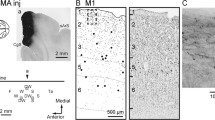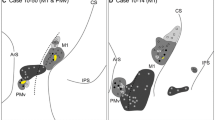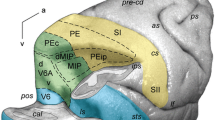Summary
Neuronal tracers (diamidino yellow or wheat germ agglutinin conjugated with horseradish peroxidase) were injected in the arm representations of area 6aα (mesial surface, area F3), in the arm representation of area 6aβ (mesial surface) as well as in the eye field of area 6aβ (dorso-medial surface). The results showed that the arm representation of area F3 receives topographically organized afferents from motor and premotor areas (areas F1, F2, F4 and F5). A further connection was found with that part of cingulate cortex that sends projections to the spinal cord. In contrast, the arm representation of area 6aβ receives afferents chiefly from area F5, the prefrontal cortex and that part of cingulate sulcus which has few, if any, connections with the spinal cord. No connections were found with the precentral motor cortex (area F1). The area 6aβ eye field receives afferents mostly from the frontal eye field. Further connections are with the prefrontal cortex and cingulate gyrus. It is suggested that the so called “low level” motor functions of supplementary motor area are due to the activity of area F3, whereas the so called “high level” motor functions depend upon an independent area located in area 6aβ.
Similar content being viewed by others
References
Bonin G von, Bailey P (1947) The neocortex of Macaca mulatta. University of Illinois Press, Urbana
Brinkman C, Porter R (1979) Supplementary motor area in the monkey: activity of neurons during performance of a learned motor task. J Neurophysiol 42:681–709
Deecke L, Kornhuber HH (1978) An electrical sign of participation of the mesial ‘supplementary’ motor cortex in human voluntary finger movement. Brain Res 159:473–476
Gentilucci M, Fogassi L, Luppino G, Matelli M, Camarda R, Rizzolatti G (1988) Functional organization of inferior area 6 in the macaque monkey. I. Somatotopy and the control of proximal movements. Exp Brain Res 71:475–490
Hummelsheim H, Bianchetti M, Wiesendanger M, Wiesendanger R (1988) Sensory inputs to the agranular motor fields: a comparison between precentral, supplementary-motor and premotor areas in the monkey. Exp Brain Res 69:289–298
Hutchins KD, Martino AM, Strick PL (1988) Corticospinal projections from the medial wall of the hemisphere. Exp Brain Res 71:667–672
Keizer K, Kuypers HGJM (1989) Distribution of corticospinal neurons with collaterals to the lower brain stem reticular formation in monkey (Macaca fascicularis). Exp Brain Res74:311–318
Kuypers HGJM (1981) Anatomy of the descending pathways. In: Brooks VB (eds) Handbook of physiology, Vol II. Motor control, Part 1. American Physiological Society, Bethesda MD, pp 597–666
Mcpherson JM, Marangoz C, Miles TS, Wiesendanger M (1982) Microstimulation of the supplementary motor area (SMA) in the awake monkey. Exp Brain Res 45:410–416
Mann SE, Thau R, Schiller PH (1988) Conditional task-related responses in monkey dorsomedial frontal cortex. Exp Brain Res 69:460–468
Matelli M, Luppino G, Rizzolatti G (1985) Patterns of cytochrome oxidase activity in the frontal agranular cortex of macaque monkey. Behav Brain Res 18:125–137
Mesulam MM (1982) Priciples of horseradish peroxidase neurohistochemistry and their applications for tracing neural pathways. In: Mesulam MM (eds) Tracing neural connections with horseradish peroxidase. Wiley, Chichester, pp 1–152
Mitz AR, Wise SP (1987) The somatotopic organization of the supplementary motor area: intracortical microstimulation mapping. J Neurosci 7:1010–1021
Miyata M, Sasaki K (1984) Horseradish peroxidase studies on thalamic and striatal connections of the mesial part of area 6 in the monkey. Neurosci Lett 49:127–133
Murray E, Coulter JD (1981) Organization of corticospinal neurons in the monkey. J Comp Neurol 195:339–365
Penfield W, Welch K (1951) The supplementary motor area of the cerebral cortex. Arch Neurol Psychiat 66:289–317
Rizzolatti G (1989) Functional properties of a mesial premotor area (area F6) in the macaque monkey. Proc. XXXI Intern Congress Physiological Sciences, S 5045
Rizzolatti G, Camarda R, Fogassi M, Gentilucci M, Luppino G, Matelli M (1988) Functional organization of inferior area 6 in the macaque monkey. II. Area F5 and the control of distal movements. Exp Brain Res 71:491–507
Rizzolatti G, Gentilucci M, Camarda R, Gallese V, Luppino G, Matelli M, Fogassi L (1990) Neurons related to reaching-grasping arm movements in the rostral part of area 6 (area 6aβ). Exp Brain Res (press)
Roland PE, Larsen NA, Shinhoj E (1980) Supplementary motor area and other cortical areas in organization of voluntary movements in man. J Neurophysiol 43:118–136
Schlag J, Schlag-Rey M (1987) Evidence for a supplementary eye field. J Neurophysiol 57:179–200
Schell GR, Strick PL (1984) The origin of thalamic inputs to the arcuate premotor and supplementary motor areas. J Neurosci 4:539–560
Tanji J, Kurata K (1985) Contrasting neuronal activity in supplementary and precentral motor cortex of monkeys. I. Responses to instructions determining motor responses to forthcoming signals of different modalities. J Neurophysiol 53:129–152
Tanji J, Okano K, Sato KC (1987) Relation of neurons in the nonprimary motor cortex to bilateral hand movement. Nature 327:618–620
Vogt O, Vogt C (1919) Ergebnisse unserer Hirnforschung. J Psychol Neurol (Leipzig) 25:277–462
Weinrich M, Wise SP (1982) The premotor cortex of the monkey. J Neurosci 2:1329–1344
Wiesendanger M (1986) Recent developments in studies of the supplementary motor area of primates. Rev Physiol 103:1–59
Wiesendanger R, Wiesendanger M (1985) The thalamic connections with medial area 6 (supplementary motor cortex) in the monkey (Macaca fascicularis). Exp Brain Res 59:91–104
Wiesendanger M, Hummelsheim H, Bianchetti M, Chen DF, Hyland B, Maier V, Wiesendanger R (1987) Input and output organization of the supplementary motor area: discussion. In: Ciba Foundation Symposium 132. Motor areas of the cerebral cortex, pp 53–62
Wise SP, Mauritz KH (1985) Set-related neuronal activity in the premotor cortex of rhesus monkeys: effects of changes in motor set. Proc R Soc L B 223:331–354
Woolsey CN, Settlage PH, Meyer DR, Sencer W, Pinto Hamuy T, Travis AM (1952) Patterns of localization in precentral and “supplementary” motor areas and their relation to the concept of a premotor area. Res Publ Assoc Nerv Ment Dis 30:238–264
Author information
Authors and Affiliations
Rights and permissions
About this article
Cite this article
Luppino, G., Matelli, M. & Rizzolatti, G. Cortico-cortical connections of two electrophysiologically identified arm representations in the mesial agranular frontal cortex. Exp Brain Res 82, 214–218 (1990). https://doi.org/10.1007/BF00230855
Received:
Accepted:
Issue Date:
DOI: https://doi.org/10.1007/BF00230855




